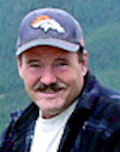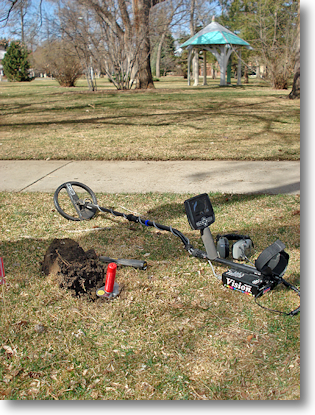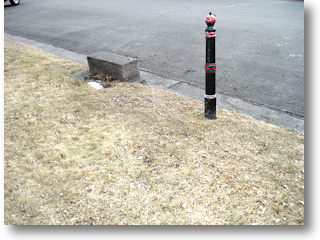THE ANATOMY OF A PARKWAY STRIP

CyberSage (Jack)
OLD PARKS
A lot of old parks within the city are surrounded by sidewalks. This leaves a parkway strip around the entire edge of the park. Now you would think that these areas would have been hunted as hard as the parks themselves over the years, but more often than not, these areas are just full of keepers. I would venture to say that the higher level of trash in these areas has something to do with this. I think there is another reason as well. All to often the average detectorist climbs out of their vehicle and heads to the inner park to start their hunt, walking right over the parkway and consequently right over those great old keeps waiting to be dug. I have dug many a nice finds around parks, and especially in the corner areas where parking is limited, but walking traffic is high.

Just across The sidewalk lay the tempting old park. Sticking to the parkway strip brought me many good finds on this hunt, including a Barber Dime that came from this dig.
Some things to keep in mind when hunting the sidewalks around a park environment is that most likely the sidewalks where put in many years after the park had been established, so make sure and hunt right up to the curb and sidewalk. Coins could have been dropped in these areas before the sidewalk. If you happen to see a city crew getting ready to replace areas of sidewalks make sure and return in the evening or weekend and hunt the work area. Often parks had a main entrance that is not obvious in modern times. Make sure and do your research on the parks as it will tell you about their surroundings as well.
THE OBVIOUS LOCATION
Here is one of those obvious locations. This old hitching post and mounting block, also known as a mounting step, are not just decorations. In this case, the curb was poured around the around the block. A nice little wheat penny came out of this area, just down the parkway about 10 feet.

That's right, the obvious location. Lastly, lets talk about the great coins that are exactly where you would expect them to be. The parkways around old churches, schools, and old storefronts are very good detecting locations and should not be overlooked. You would not believe how many detectorists pass right by these places with the assumption anything worth finding has already been found by others. Never say hunted out! You may have to take a slightly different approach to how you hunt it though. I hunt these areas with the idea that the coins are there because they where missed for a reason. Our job is to figure out what that reason is. When I dig a good target one of my first questions is not, "Why did I find this?" Rather I ask, "Why did someone else not find this?" You can learn a lot about digging keepers out of heavily hunted areas when you look at each find with this perspective. Let's take a look at some of the common reasons for missing good targets and some solutions to overcome them.
Depth
Simply put, the target was too deep to be detected by your detector. You will notice that in most of the pictures in this article I am using a 12" concentric coil. Most detectorists would choose a smaller coil to deal with trash better. This is a good example of taking that different approach I was telling you about. Sometimes that nice little Barber Dime is just sitting right there in the open, just out of reach. It also brings us to the next common cause for missing targets.
Masking or Nulling
This is a good target lying to close to an undesirable target. There are many ways to go about dealing with this problem. The most obvious is using a smaller or DD coil. There goes your depth again. So how do we handle this? Without getting to detector specifics, the idea is to move the coil slower over the ground with shorter swing widths. Use the settings of the detector to compliment this. Slower recovery times and less discrimination will be a step in the right direction. If you have a great looking area, spend some time digging out the junk iron, bottle caps, and nails. Quite often you will be rewarded with a shiny silver coin.
Coil Barriers
Often, proximity to other objects that doesn't allow enough of a coil swing to cause a response to the target can pose another hurdle to the inexperienced detectorist. We talked about this earlier in dealing with concrete curbs and sidewalks, but there are other objects to deal with such as trees, bushes, posts, and other miscellaneous items. Now, you have heard the advice "low and slow" and "keep the coil level". That works great if you have flat ground, but in order to get close to the above obstacles you are going to have to make some allowances. Turn that coil at a 45-degree angle and swing around the base of that old tree and its roots. Treat all those other tight areas the same. This does not mean you have to get down in an uncomfortable position to swing. Just reach down and pivot the coil back where it mounts to the shaft. You can turn it completely flat and reach under bushes. Be creative in finding ways to swing that coil where the last guy didn't.
Coverage
This is probably the biggest reason for missed targets. A wise man by the name of Rudy once told me, "The reason you did not find it, was that your coil never passed over it". Sounds simple, doesn't it? I can't stress this enough. When you hunt an area, move at a relaxed and slow pace. Watch your coil and work possible good hits from all directions. Change coils and hit it again. Be thorough in your hunt. When it rains and the ground is soaking wet, go back and hunt it again. Don't ever say hunted out. When you pull that beautiful old coin out of the ground it will because of your hard work and determination that the last guy didn't have. Trust me on this. There are wonderful finds waiting for you down at that local park.
EMI
A lot of times the older parkway areas will be surrounded by modern day technology that causes Electro Magnetic Interference. This can drive your detector nuts, and cause you to use much lower sensitivity settings than you normally might. There is not much you can do in a situation like this. Hunting in early morning or late evening can sometimes help. Smaller DD style coils can help as well. Continue to check these areas often, and you may find one day that the EMI has diminished enough to get down to that old coin that has been lying in wait.
Don't be one of those detectorists that pass up great locations because you think they are hunted out. Go back again and again and you will be rewarded. Granted, it does not have the excitement of a virgin private property, but you will make some good finds. I can tell you without hesitation that my most prized finds came from areas just like this. You will certainly always have historic surroundings to enjoy, and the possibility of getting a chance to hunt that glorious old property that lies just across the sidewalk. The obvious areas will sometimes prove to be a surprise in that they may have never been hunted as hard as you might think, or (more importantly) as hard as what the last detectorist thought. I have had this happen. I hunted a parkway in front of an old college hall (dorm) one time that produced multiple pocket spills and gave up seven silver dimes and many wheats before the hunt was over. It was an obvious area. So get out there and make your own luck! It is important to remember that taking the time to go back to these areas for new perspective on the same old ground will put many nice finds on your trophy shelf.
CONCLUSION
We have covered a lot of ground here, so to speak, and hopefully you now have some new ideas that will improve your old coin finds. There are many clues and signs that point to where to find that old coin, but sometimes the hard part is seeing these little markers that will show you the way to digging up the past. Always be on the lookout for change in progress. So often these little opportunities present themselves for such a short, fleeting moment. If you frequent those old areas of town on a regular basis, you will see these little windows come and go and learn to recognize them by the signs we have talked about. Let each good find be a learning tool. Try to figure out why today was the day that old coin saw the light of day again. Above all, never say hunted out! As you hunt these parkways, remember that this is potentially a staging ground for a great hunt just across the sidewalk on that private property. Take care not to do damage, and leave things better than you found them. Work with the landowner and be respectful of his property. Always check local laws and easement policies. Be friendly in nature and take time to talk with locals. Remember that you and your actions are constantly on display, and always up for review. Take advantage of this opportunity to make a good impression.
In closing, I would leave you with a little food for thought. There is truly no place for frustration and disappointment in any good treasure hunt. The greatest loss of man is not the coins that lay buried in the ground under his feet, but rather the history and knowledge of his existence gradually fading away. In your search, first look for the individual who lost the coin and you will never come home empty handed.
Keep Swing'in
Jack
|